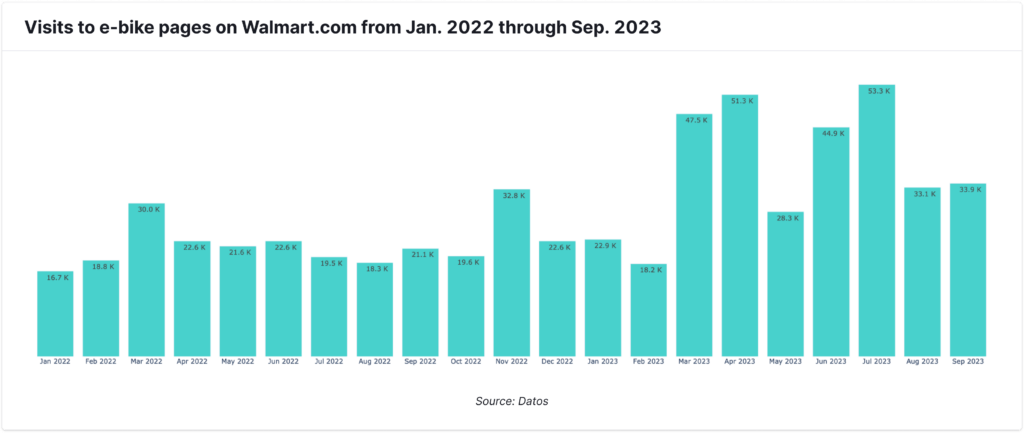Despite strong buzz and dozens of entrants, e-bikes fail to inspire the online marketplace.
Over the past several years we’ve seen many entries into the electric bike (or e-bike) space from specialty manufacturers, like Electra and Blix, as well as from some of the biggest players in cycling, like Trek and Specialized.
And the reason behind this push is clear.
Right now there is the clear call from a majority of the world’s science community and climate change researchers that we must drastically reduce greenhouse emissions immediately or risk more global warming and a worsening climate crisis. So in response, many companies are racing to present alternative forms of transportation—primarily in the form of electric vehicles.
Bikes are not cars
Most of you are probably already familiar with the much more prominent electric car and truck market. There is some truly sizable interest in this arena and it’s presumably a big factor in why so many companies believed e-bikes would follow a similar trajectory.
The problem is this is simply not the case.
We consulted the clickstream data for general “e-bike” and “e-bikes” searches over a period of two years (September 2021 – August 2023). But despite the hype, we saw no appreciable rise in consumer interest over this timeframe.
Worse yet, overall web searches were so low in every month we looked at, we can comfortably claim that any interest shown is completely negligible. Even the marginal growth from 2021 to 2022 cannot be considered significant. Then interest stagnates from 2022 to 2023, with some inconclusive seasonal bumps during the Spring and Summer months.


We found a similar story on Walmart.com, where traffic was still not high enough to offer any statistical relevance. Plus, once again, the small spikes are obviously tied to seasonal interest and not significant signs of the U.S. population embracing the product category.

The potential is still there
At this point it’s probably worth mentioning that despite not finding a massive trend—as the hype machine would have us believe there is—the e-bike market does still have tremendous opportunity for growth.
After crunching some numbers, we found that the average price of an e-bike is about $2,000, while the median price is about $6,000. Overlaying these price points does much to explain the lower demand today. E-bikes are simply too expensive to be considered anything other than an enthusiast product at this point in the product evolution.
We also need to take into account the seasonality of the products. Even if you were to consider this as a commuter vehicle, it’s still a lot of money to pay for something the average U.S. consumer will only get to comfortably use for six months each year at most.
All this to say, like most enthusiast products, when the prices begin to fall, interest should tick up as the product gains broader acceptance. Additionally, with many cities adding or expanding dedicated bike lanes—increasing both safety and ease for commuting—we should see more people considering e-bikes as a viable form of transportation.
We can similarly posit that e-bikes are more likely to catch on faster in Europe and southeast Asia, where cycling is already afforded more accommodation and consumer support. However, in the U.S. don’t expect any major growth in this sector any time soon.
How to navigate the e-bike market right now
Given that it’s highly unlikely there will be a sudden reduction in parts prices and a dramatic lowering of the consumer cost, manufacturers and retailers of e-bikes need to take a more pragmatic approach in their marketing for the immediate future.
Since the customer base is presumably composed almost entirely of enthusiasts at this stage, now is the time to focus on loyalty and advocacy efforts. Everything from user clubs to live meet-ups and events to influencer efforts to rewards programs need to take centerstage.
Whatever motivates your already excited customers to share openly and often about the benefits of your product will serve you well in the long term. Even if it doesn’t bring any immediate rise in sales volume, these recommendations will earn you more brand cachet than many of the more traditional media options for awareness building.
Public relations should also become a focus. Too many of us think of PR as little more than sending press releases to journalists about new products. However, a good practitioner can also leverage long-standing editorial contacts to get you included in news stories about climate change, alternative commuting options and the like. This then frames the conversation about e-bikes in the light of taking definitive action to better the world, increasing overall interest, desirability, and meaning associated with your product.
Finally, take time to grow your content library to become the authoritative destination for the e-bike category as a whole, rather than just a website about your product. With so little traffic volume right now, it’s important to raise organic, in-bound interest. And few things capture the attention of search engines like legitimate authority on a subject.





